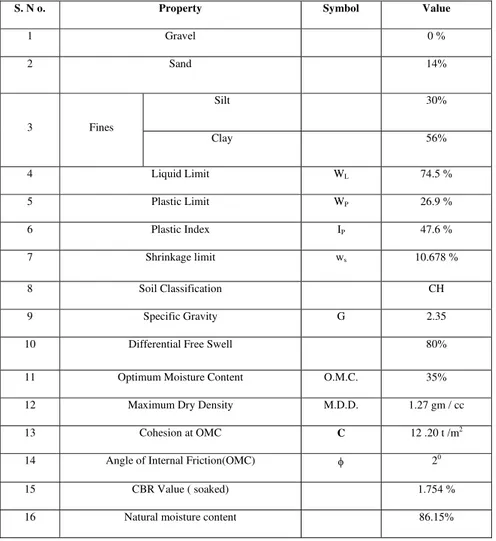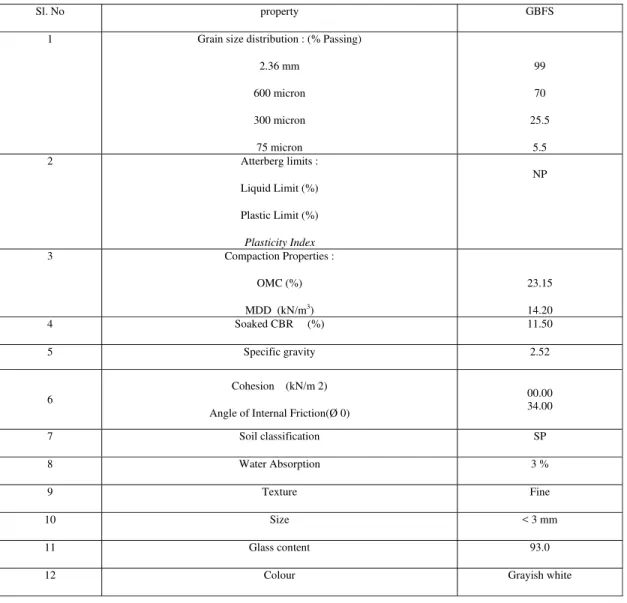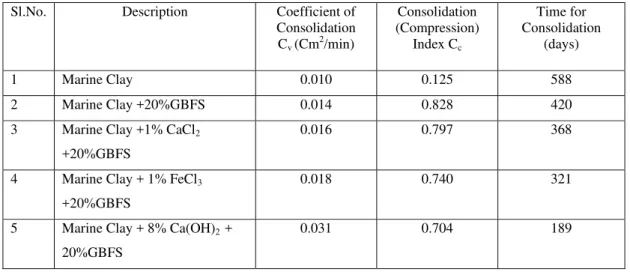CONSOLIDATION CHARACTERISTICS
OF TREATED MARINE CLAY FOR
FOUNDATION SOIL BEDS
D. Koteswara Rao G.V.R. Prasada Raju K. Ashok Kumar
Associate Professor Professor P.G. Student (PTPG) -2011 Department of Civil Engineering
University College of Engineering KAKINADA -533 003, A.P, INDIA.
ABSTRACT
In general, the soils which exist in the coastal corridors are Soft Marine Clays, formed by the deposits and these are generally weak and highly compressible in nature. The present study deals with the strength characteristics of the untreated and treated marine clay collected from Kakinada Sea Port Ltd, Kakinada, A.P, India. The Consolidation properties, and the strength properties of the untreated and treated Marine Clay with effect of GBFS, Calcium Chloride, Ferric Chloride and Lime has been determined in this study and the detailed test results are also discussed.
KEY WORDS : Marine Clay, GBFS, CaCl2, FeCl3, Ca(OH)2, OMC, CBR, Consolidation Characteristics,
Coefficient of Consolidation, Coefficient of Compression, Rate of Settlement.
1.1INTRODUCTION
Generally, the marine clay is available at fully saturated condition in the costal corridor and the natural water content of the marine clays is always greater than its liquid limit. The comprehensive review of literature shows that a considerable amount of work is related for the determination of consolidation characteristics, deformation characteristics and strength characteristics of marine clay, has been carried out worldwide almost since last 50 years. From the various contributions, the investigations on consolidation & deformation characteristics and strength characteristics of marine clay conducted by S. Narasimha Rao et.al (1987,1996), Shridharan et al.(1989) , Mathew et al. (1997) and G. Rajasekaran et.al(2002), Ali M.A. Abd-Allah(2009)are worthy of note. Improving the strength of the marine clay by the stabilization technique was performed by Supakij Nontananandh et al. (2004). Countable study on engineering properties of marine clays was performed by Basack et al (2009).
The effect of electrolytes on soft soils were explained by Bolt, G.H (1956),Slate et.al (1958),Anandakrishnan et.al (1966), Sivanna, G.S (1976), Saha et.al (1991), Rao, M.S et.al(1992), Sivapullaiah, P.V. et al (1994), Bansal et.al(1996), S. Narasimha Rao et.al(1996), Appamma, P.,(1998), Chandrashekar et.al (1999),G. Rajasekaran et.al (2000),J. Chu et.al (2002),Matchala Suneel et.al (2008). The effect of steel industrial wastes on soft soils were presented by Ashwani Kumar et.al (1998), Bhadra, T. K et.al (2002), Dr. D. D. Higgins (2005), Koteswara Rao (2006),
Marine clay is uncommon type of clay and normally possesses in soft consistency. Marine clay deposits of Kakinada were used for the testing with the aim to investigate its consolidation and strength characteristics and further make suitable for foundation constructions or sub-grades over it. The soil was collected at 0.3m to 1.0m depth from the Kakinada Sea Ports limited, Kakinada, A.P, India and used for the study.
1.2 OBJECTIVES
This study has been carried out with the following objects
To study the consolidation characteristics of untreated marine clay
To study the effect of lime, calcium chloride, ferric chloride and GBFS on the consolidation properties of marine clay
1.3.1 Marine clay
The marine clay was collected from the Kakinada Sea Ports limited, Kakinada at a depth of 0.3m. Kakinada port is situated on the east coast of India at a latitude of 160 56' North and longitude of 820 15' East. Soft marine clays are very sensitive to changes in the stress system, moisture content and system chemistry of the pore fluid. Geotechnical engineers feel a necessity to improve the behavior of these deposits using anyone of the available ground improvement techniques.
1.3.1.1 Geotechnical Properties
The soil was initially air dried in open atmosphere prior to the testing. The various Geotechnical properties i.e. particle size distribution, Differential free swell, swell pressure, atterberg limits, strength parameters etc are described in this study and tabulated in the Table 1.
1.3.2 Granulated Blast Furnace Slag (GBFS)
Granulated blast furnace slag used for this study was brought from Vizag steel plant, Visakhapatnam, Andhra Pradesh, A.P, India. Various laboratory tests were conducted to determine the properties of GBFS as per IS codes of practice.
1.3.2.1 Physical Properties of GBFS
The physical properties of GBFS were determined by adopting appropriate laboratory testing procedures and the results are summarized in Table 2.
Table 1: Geo–Technical Properties of the soil
S. N o. Property Symbol Value
1 Gravel 0 %
2 Sand 14%
3 Fines
Silt 30%
Clay 56%
4 Liquid Limit WL 74.5 %
5 Plastic Limit WP 26.9 %
6 Plastic Index IP 47.6 %
7 Shrinkage limit ws 10.678 %
8 Soil Classification CH
9 Specific Gravity G 2.35
10 Differential Free Swell 80%
11 Optimum Moisture Content O.M.C. 35%
12 Maximum Dry Density M.D.D. 1.27 gm / cc
13 Cohesion at OMC C 12 .20 t /m2
14 Angle of Internal Friction(OMC) 20
15 CBR Value ( soaked) 1.754 %
1.3.3 Ferric Chloride (FeCl3)
Commercial grade Ferric Chloride (consisting of 69% ferric chloride +16% sodium chloride + 15% calcium oxide) was used in this study. The quantity of ferric chloride was varied from 0 to 2% by dry weight of soil.
1.3.4 Calcium Chloride (CaCl2)
Commercial grade calcium chloride (consisting of 58% calcium chloride +42% magnesium chlorides) was used in this investigation. The quantity of calcium chloride was varied from 0% to 2% by dry weight of soil.
Table 2: Properties of GBFS
Sl. No property GBFS
1 Grain size distribution : (% Passing)
2.36 mm 600 micron 300 micron 75 micron
99 70 25.5
5.5
2 Atterberg limits :
Liquid Limit (%) Plastic Limit (%) Plasticity Index
NP
3 Compaction Properties :
OMC (%) MDD (kN/m3)
23.15 14.20
4 Soaked CBR (%) 11.50
5 Specific gravity 2.52
6
Cohesion (kN/m 2) Angle of Internal Friction(Ø 0)
00.00 34.00
7 Soil classification SP
8 Water Absorption 3 %
9 Texture Fine
10 Size < 3 mm
11 Glass content 93.0
12 Colour Grayish white
1.3.5 Lime (Ca(OH)2)
Commercial grade lime mainly consisting of 58.67% of Cao and 7.4% Silica was used in the study. The quantity of lime was varied from 0% to 10% by dry weight of soil.
1.4 CALIFORNIA BEARING RATIO (CBR) TEST
on % variation of GBFS
Mix Proportion OMC (%) MDD(g/cc) CBR (%) 100% soil 35 1.27 0.74
85%Soil+15%GBFS 21.5 1.601 1.19 82%Soil+18%GBFS 23 1.621 1.34 80%Soil+20%GBFS 23.5 1.635 3.80 78%Soil+22%GBFS 21.5 1.591 2.39 76%Soil+24%GBFS 22.8 1.582 1.56
1.5 OMC, MDD AND CBR VALUES OF MARINE CLAY +20% GBFS ON THE % VARIATION OF FECL3, CACL2, CA(OH)2
It was noticed from the Table 4, the optimum MDD and CBR values were obtained for the 80%Soil+20%GBFS mix with the effect of 1% FeCl3, 1% CaCl2, and 8% Ca(OH)2.
Table4:OMC, MDD and CBR values of Marine Clay +20%GBFS on the % variation of FeCl3, CaCl2, Ca(OH)2
Mix Proportion OMC (%) MDD (g/cc) CBR (%)
80%Soil+20%GBFS 23.5 1.635 3.80 80%Soil+20%GBFS+0.25% FeCl3 18.01 1.656 3.88
80%Soil+20%GBFS+0.5% FeCl3 18.26 1.677 4.18
80%Soil+20%GBFS+1% FeCl3 19.17 1.689 6.05
80%Soil+20%GBFS+2% FeCl3 23.74 1.596 4.33
80%Soil+ 20%GBFS+0.5% CaCl2 14.36 1.622 4.78
80%Soil+ 20%GBFS+1% CaCl2 18.36 1.830 5.52
80% SOIL+ 20% GBFS +1.5% CaCl2 20.31 1.670 5.07
80%Soil+20%GBFS+4% Ca(OH)2 18.26 1.451 6.35
80%Soil+20%GBFS+5% Ca(OH)2 19.05 1.468 8.36
80%Soil+20%GBFS+6% Ca(OH)2 20.12 1.489 10.51
80%Soil+20%GBFS+7% Ca(OH)2 21.50 1.522 11.71
80%Soil+20%GBFS+8% Ca(OH)2 22.15 1.546 12.52
80%Soil+ 20%GBFS+9% Ca(OH)2 23.51 1.511 11.50
80%Soil+ 20%GBFS+10% Ca(OH)2 23.81 1.473 9.65
1.6 Discussion
The substantial improvement in the marine clay properties could be attributed to the depressed double layer thickness due to cation exchange and increased electrolyte concentration as the chemical is completely soluble in water. It was observed from the results that, there was an increase in the soaked CBR values with increase in percent of ferric chloride up to 1% and there after it decreases with further addition of Ferric Chloride and also the same phenomena has been taken place in case of calcium chloride. The increase in strength with the addition of Ferric Chloride may be attributed to the cation exchange reactions. The reduction in strength beyond 1% FeCl3 may be due to adsorption of more moisture at higher FeCl3 content and also the same in case of calcium
chloride.
The increase in the CBR values of the “80% marine clay+20%GBFS” mix on the effect of optimum of 8% Ca(OH)2 may be attributed to the cation exchange reactions. The reduction in strength beyond 8% Ca(OH)2 may
be due to adsorption of more moisture at higher Ca(OH)2 content.
1.7 Effect of GBFS and Chemical additives on the Consolidation Characteristics of Marine Clay
The consolidation tests were conductedwith the addition of the optimum percentages of calcium chloride, ferric chloride, lime and GBFS to determine the time required for the Consolidation, Coefficient of consolidation and Compression Index of the marine clay as given in the Table 5.
Consolidation Characteristics
The time required for the consolidation, coefficient of consolidation and Compression Index of untreated and treated (with BGFS, CaCl2, FeCl3 and Ca(OH)2) marine clay were determined by using a standard method and
Rate of Consolidation of Treated and untreated Marine Clay
Sl.No. Description Coefficient of Consolidation
Cv (Cm2/min)
Consolidation (Compression)
Index Cc
Time for Consolidation
(days) 1 Marine Clay 0.010 0.125 588 2 Marine Clay +20%GBFS 0.014 0.828 420 3 Marine Clay +1% CaCl2
+20%GBFS
0.016 0.797 368
4 Marine Clay + 1% FeCl3
+20%GBFS
0.018 0.740 321
5 Marine Clay + 8% Ca(OH)2 +
20%GBFS
0.031 0.704 189
60 65 70 75 80 85 90
0 1 2 3 4 5 6 7 8 9 10 11 12 13 14 15 16
√T - TIME
DI
AL
GUA
G
E
RE
ADI
N
GS
Fig 3: Consolidation Characteristics of Marine Clay
R
RO
R9
√T=9.2
CV=0.848H2/t9 0=0.848(1.0)2/84.64
=0.010cm2/min
Time required for 1m. thick layer consolidation
t = 0.848H2/CV = 0.848 X1002/0.010 = 848000 min. = 588.8 days
Consolidation Index CC= e1-e2/log10(σ2/σ1)
60 65 70 75 80 85 90
0 1 2 3 4 5 6 7 8 9 10 11 12 13 14 15 16 √T - TIME
D
IAL
G
U
AG
E
R
E
AD
IN
G
S
Fig 4: Affect of 20%
GBFS
on the Consolidation Characteristics of Marine ClayR
RO
R
√T=7.7
CV=0.848H2/t90 =0.848(1.0)2/59.29
=0.014cm2/min
Time requiredfor 1m. thick layer
consolidation t = 0.848H2/C V = 0.848 X1002/0.014 = 605714 min. = 420.6 days
60 65 70 75 80 85 90
0 1 2 3 4 5 6 7 8 9 10 11 12 13 14 15 16
√T - TIME
D
IAL
G
U
A
G
E
R
E
AD
IN
G
S
R RO
R9
√T=7.2
CV=0.848H2/t90 =0.848(1.0)2/51.84
=0.016cm2/min
Time required for 1m. thick layer consolidation
t = 0.848H2/CV = 0.848 X1002/0.016 = 530000 min. = 368.05 days
Consolidation Index
CC= e1‐e2/log10(σ2/σ1)
= 0.79‐0.66/log10(41.5/28.5)
= 0.797
Fig 5: Affect of 1%CaCl2 + 20%GBFS on the Consolidation Characteristics
1.8 CONCLUSIONS
The following conclusions are drawn based on the laboratory studies carried out on this study.
It was observed that the CBR value of the marine clay has been increased by 413% with the addition of optimum of 20% GBFS.
It was also experienced that the CBR values of “80% marine clay + 20% GBFS” mix has been improved by 59%, 45% and 229% with addition of FeCl3, CaCl2 and Ca(OH)2 respectively.
It was noticed that the Coefficient of Consolidation of the marine clay was increased by 40%, 60%, 80%, and 210% with the addition of 20%GBFS, 1%CaCl2+20% GBFS, 1% FeCl3+20% GBFS and 8%
Ca(OH)2+20% GBFS respectively.
It was observed that the Compression Index of the marine clay was improved by 562%, 537%, 492% and 463% with the addition of 20%GBFS, 1%CaCl2+20% GBFS, 1% FeCl3+20% GBFS and 8%
Ca(OH)2+20% GBFS respectively.
Further, it was identify that the time required for the 90% consolidation of the marine clay was decreased by 29%, 37%, 45% and 68% with the addition of 20%GBFS, 1%CaCl2+20% GBFS, 1%
FeCl3+20% GBFS and 8% Ca(OH)2+20% GBFS respectively.
60 65 70 75 80 85 90
0 1 2 3 4 5 6 7 8 9 10 11 12 13 14 15 16
√T - TIME
DIA L GU A G E RE A D IN GS
Fig 6: Affect of 1%FeCl 3+20% GBFS on the Consolidation Characteristics of Marine Clay R RO R90
√
T=6CV=0.848H2/t90 =0.848(1.0)2/46.24
=0.0183 cm2/min
Time required for 1m. thick layer consolidation
t = 0.848H2/C V
= 0.848 X1002/0.0183
= 463388 min.
Consolidation Index CC= e1-e2/log10(σ2/σ1)
= 0.74-0.62/log10(39.65/27.3) 60 65 70 75 80 85 90
0 1 2 3 4 5 6 7 8 9 10 11 12 13 14 15 16
√T - TIME
Fig. 7: Affect of 8%Ca(OH)2+20% GBFS on the Consolidation Characteristics of Marine Clay
R
RO
R9
√T=5.2
CV=0.848H2/t90
Time required for 1m. thick layer consolidation
t = 0.848H2/CV = 0.848 X1002/0.031 = 273548 min. = 189.9 days
Consolidation Index
CC= e1‐e2/log10(σ2/σ1)
CC= 0.73‐0.63/log10(37.9/27.3) = 0.704 DIA L GU A G E RE A D IN GS R RO R9
√T - TIME
Fig. 7: Affect of 8%Ca(OH)2+20% GBFS on the Consolidation Characteristics of Marine Clay
R
RO
R9
√T=5.2
CV=0.848H2/t90
Time required for 1m. thick layer consolidation
t = 0.848H2/CV = 0.848 X1002/0.031 = 273548 min. = 189.9 days
Consolidation Index
CC= e1‐e2/log10(σ2/σ1)
CC= 0.73‐0.63/log10(37.9/27.3) = 0.704 DIA L GU A G E RE A D IN GS R RO
R9 0.848(1.0)
2/27.04
REFERENCES
[1] A, Rao SM, Chandrasekaran S (1989), “Engineering Properties of Cochin and Mangalore Marine Clays”, Indian Geotech, J.1:265-278. [2] A l i M .A . A b d - Al l a h , Y e h i a H . D a wo o d , S a m i r A . A w ad an d W al e e d A. A g i l a ( 2 0 0 9 ) , M i n er a l o g i c a l an d
Ch e mi c a l Co m p o s i t i o n s o f S h a l l o w M ar i n e C l a ys , E as t o f C a i r o , Eg yp t : A G e o t e ch n i c a l p er c ep t i o n , J K A U : E r at h N o . 1 , p p 1 4 1 - 1 6 6 ( 2 0 0 9 A. D / 1 4 3 0 A . H.
[3] Anandakrishnan, M. and Dhaliwal, S.S.(1966), Effect of various concentrations of Sodium Chloride and Calcium Chloride on the pore pressure parameters and on strength parameters of Black Cotton Soil, Research Report, Dept. of Civil Engg., IIT, Kanpur, India, 1966. [4] Appamma, P.,(1998), Strength characteristics of Ca -Rice husk ash stabilized soil mixes, M.Tech., thesis, Department of Civil Engg.
JNTU, Kakinada, 1998.
[5] Ashwani Kumar and H.S. Mehta (1998), Laboratory Investigations on Use of Stabilized Granulated Blast Furnace Slag in Roads, Indian Highways, December 1998.
[6] Bansal, R.K., Pandey, P.K. and Singh, S.K.,(1996), Improvement of a Typical Clay for Road Subgrades with Hydrated Lime, Proc. Of National Conf. on Problematic Subsoil Conditions, Terzaghi-96, Kakinada, India, 1996, pp. 193-197.
[7] Basack and Purkayastha (2009). “Engineering properties of Marine Clays from the eastern coast of India.”Journal of Engineering and Technology Research Vol.1(6),pp.109-114,September, Shridharan 2009.
[8] Bhadra, T. K and Sandhawar, R. R (2002), Design of roads using waste products from steel plants, Indian Highways. [9] Bolt, G.H (1956), Physico-Chemical analysis of the compressibility of pure clays, Geotechnique VI, 1956, pp. 86-93.
[10] Chandrashekar, B.P., Prasada Raju, G.V.R (1999), Relative Performance of Lime and Calcium Chloride on Properties of Expansive Soil For Pavement Subgrades, Proc. Of IGC-99, Calcutta, 1999, pp 279-282.
[11] D. Koteswara Rao (2006), Laboratory investigations on GBFS-CH soil mixes for the utilization of foundation beds, CONCEPTS-2006, J.N.T.University College of Engineering, Kakinada, July 2006.
[12] Dr. D. D. Higgins (2005), Soil Stabilization with Ground Granulated Blast Furnace Slag, UK Cementitious Slag Makers Association (CSMA), September 2005.
[13] G. Rajasekaran and Narasimha Rao. S (2000), Strength Characteristics of lime treated marine clay, Journal of Ground Improvement, Vol.3, pp 127-136.
[14] G. Rajasekaran and Narasimha Rao. S (2002), Compressibility behaviour of lime treated marine clay, Ocean Engineering, 29,545-559. [15] G. Rajasekaran and Narasimha Rao. S (2002), Permeability Characteristics of lime treated marine clay, Ocean Engineering, 24(2),
113-127.
[16] J.Chu, Myint Win Bo, M.F.Chang and V. Choa (2002), Consolidation and Permeability Properties of Singapore Marine Clay. Journal of Geotechnical and Geo environmental Engineering, Vol.128, No.9, September 2002, pp.724-732.
[17] Matchala Suneel, Lee Keun Park and Jong Chul Im (2008), Compressibility Characteristics of Korean Marine Clay, Marine Georesources & Geo technology, Vol.26, Issue 26, April 2008, pp 111-127.
[18] Narasimha Rao.S and Paul K (1996),”Permeability Studies in Marine Clays Stabilized with lime Column”, International Journal of offshore and Polar Engineering ,Vol.6,No.3, September 1996( ISSN 1053-5381).
[19] Rao, M.S., Sridharan, A. and Chandrakaran, S. (1992), Physico – chemical effects on the engineering behavior of Indian marine clays. Proc. ILT Seminar on problems of Lowland Development, Saga University, Saga Japan. 265-272.
[20] S. Narasimha Rao and Paul K. Mathew (1996), Permeability Studies in Marine Clays Stabilized with lime Column, International Journal of offshore and Polar Engineering ,Vol.6,No.3, September 1996( ISSN 1053-5381).
[21] S. Narasimha Rao and Sankar. N (1987), Compressibility Behaviour of Indian Marine Clays, Docks and Harbours Conf., Madras, December 1987.
[22] Saha and Saha, P (1991), Improvement of Soils by Use of Chemicals,IGC-91.
[23] Sivanna, G.S (1976), Strength and consolidation characteristics of black cotton soil with chemical additives- & ,Report prepared by Karnataka Engg. Research Station, Krishnarajasagar, India, 1976.
[24] Sivapullaiah, P.V. et al (1994), Role of Electrolytes on the Shear Strength of clayey soil, Proc. of IGC-94, Warangal, 1994, pp. 199-202.
[25] Slate, F.O. and Johnson, A.W (1958), Stabilization of Soil with calcium chloride, HRB, Bibliography-24, 1958, pp. 1-90.





